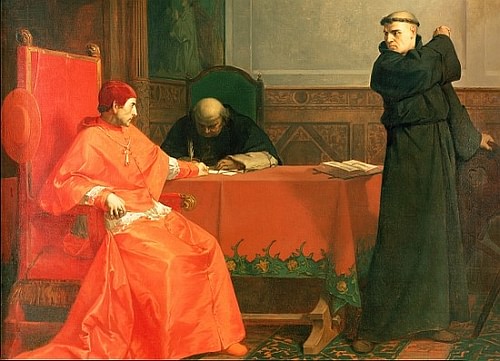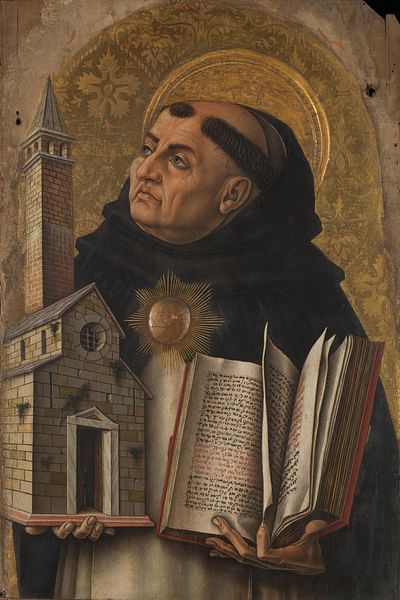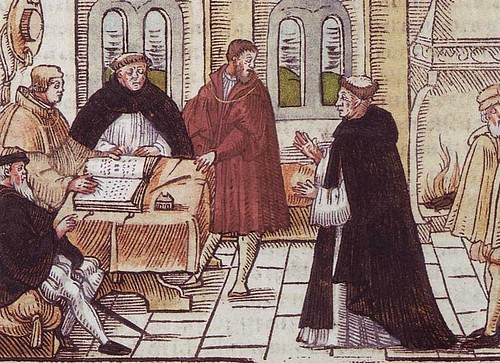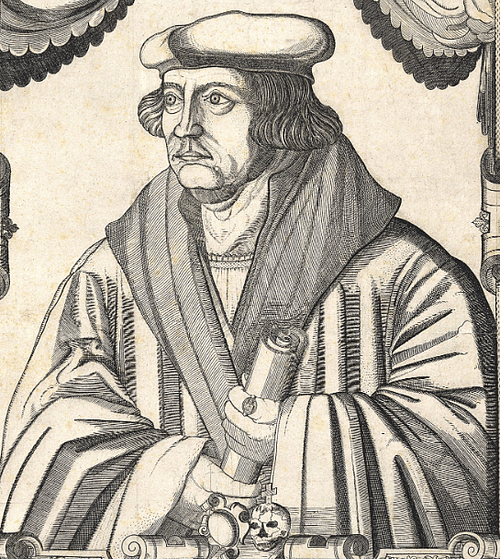
Cardinal Thomas Cajetan (l.c. 1468-1534) was a Catholic theologian and philosopher best known for his disputations with Martin Luther (l. 1483-1546) beginning in 1518. Cajetan, a philosophical Humanist, was thought to have had the best chance of convincing Luther face-to-face of his errors and, when he failed, devoted himself to refuting Luther in writing.
Cajetan was made a cardinal in 1517 and had an illustrious career beforehand as a scholar whose interpretations of the works of St. Thomas Aquinas (l. 1225-1274) were highly regarded as inspired. He was a staunch defender of the pope and papal authority but believed in approaching differing views with respect and an open mind. The ecclesiastical authorities felt this made him uniquely qualified to deal with Luther in 1518, when he was in Saxony anyway, to avoid an unpleasant and highly public trial of Luther in Rome on charges of heresy.
Cajetan prepared himself to admonish the young monk and guide him back to orthodoxy, but Luther was too well-versed in scripture and canon law to be led anywhere he did not wish to go. The meeting at Augsburg in 1518 turned into an argument and then a tournament battling over Church policy, practice, and authority. Luther left the disputation the winner and Cajetan returned to Rome where he helped draft the papal bull Exsurge Domine in 1520 as part of a committee (that included the theologian Johann Eck, l. 1486-1543) threatening Luther with excommunication after enumerating his errors.
Luther burned Exsurge Domine in December 1520 and was excommunicated in January 1521. Cajetan, like Eck and others, continued to write against Luther’s teachings – as well as the Reformers who came after him – for the rest of his life, summing up many of his major contentions in his On Faith and Works in 1532. On Faith and Works is among the clearest and best-argued refutations of Luther’s claim that a Christian’s works added nothing to one’s salvation.
Even so, it had no effect on Lutheran doctrine and Luther dismissed it as he did all of Cajetan’s works. Cajetan continued to denounce Luther as a heretic and was highly respected as a Defender of the Faith whose arguments informed the Council of Trent (1545-1563) and the Catholic Counter-Reformation (1545-c.1700).

Education & Early Career
Thomas Cajetan (also known as Gaetanus, from his hometown of Gaeta in the Kingdom of Naples), was given the name Jacopo Vio at birth. He later took the monastic name Tommaso (after Aquinas) and was known as Tommaso de Vio, Tommaso Gaetanus or, as noted, simply Gaetanus during his life. “Thomas Cajetan” is the Anglicized version of his name. Nothing is known of his early life or family, and he first appears in the historical record at age 15 when he became a Dominican monk.
By the time he was 30 years old he was a Doctor of Theology teaching at the University of Padua and had already established a name for himself as the preeminent scholar on the works of Saint Thomas Aquinas who had also been a Dominican monk. Cajetan was deeply disappointed by what he saw as the Church’s move away from Thomism (the philosophical and theological school of thought based on Aquinas’ works) and the tendency of some clergy to dismiss Thomism completely as “Dominican thought”. Cajetan argued that, since Thomism blended reason and faith seamlessly, balancing itself on the precepts of Aristotle, it should be more widely accepted by the Church. Scholar Diarmaid MacCulloch comments:
Cajetan was determined to restore Thomism to its central place in the Church, to promote Thomas’ careful balance of human reason and divine revelation in Scripture, his creative appropriation of Aristotle in order to discuss Christianity, from the most profound divine mysteries to the everyday practicalities of the Church’s mission in the world. Between 1507 and 1522, Cajetan published a commentary on the Summa Theologica, Thomas’s greatest work (which he was reputed to be able to recite by heart). His volumes proved to be a centerpiece of a major revival of interest in Aquinas’s thought. (87)
By 1508, Cajetan was the leader (general) of the Dominicans and in 1511 defended papal authority and the divine rights of the pope in a number of works which proved both influential and controversial as they clashed with the interests and philosophies of the monarchies. For his defense of papal rights and devotion to the doctrines of the Church, he was made cardinal in 1517. Cajetan’s focus on Thomism brought him in line with the scholastic theologians of his time who understood that interpretation of Scripture needed to be based on the works of the Church Fathers and ecclesiastical councils which had established certain set conclusions. This view was among the first to be attacked by the German theologian and monk Martin Luther.
Luther’s Theses
Luther’s 97 Theses (also known as his Disputation Against Scholastic Theology) was published in the fall of 1517 one month before his better-known 95 Theses and are a rejection of the Church’s approach to interpreting scripture and establishing doctrine. The work specifically attacks the use of Aristotle’s logic in matters of faith and the teachings of Aquinas which relied on Aristotle. Luther had received his doctorate after years of studying the scholastic theologians including William of Ockham (l.c. 1287-1347), Duns Scotus (l.c. 1265-1308) and Gabriel Biel (l.c. 1425-1495) all of whom he completely rejected in 1517 arguing that faith was a gift from God and scholastics complicated and confused matters of faith by application of reason.
The 97 Theses were not a rejection of reason, only of how logic was used to reach conclusions which could only be truly realized through faith. The work was only distributed locally in Wittenberg as an invitation to debate the topic – the same purpose the 95 Theses were originally supposed to serve – and so never received the attention, at the time, that the 95 Theses would after it was published and distributed widely. The prominent theologian Johann Eck immediately attacked the 95 Theses publicly and Luther became a public figure, but the 97 Theses would inform Luther’s disputation with Cajetan at Augsburg in 1518.
In October 1517, Luther had sent his 95 Theses, attacking the Church’s policy on indulgences, to his archbishop, Albrecht von Brandenburg, who had them checked for heresy and sent on to Rome. By January 1518, the 95 Theses were judged heretical and attacked by the indulgence salesman Johann Tetzel (l. c. 1465-1519) following Eck’s condemnation of the work. Throughout 1518, other Catholic theologians joined in denouncing the 95 Theses until, in August, Luther was summoned to Rome to explain himself.
Luther & Augsburg
Luther’s noble benefactor, Frederick III (the Wise, l. 1463-1525), Elector of Saxony, suggested Luther be examined on German soil and, specifically, at Augsburg since he had significant influence there. Cajetan was already in the area in the spring of 1518 to attend the Imperial Diet and was chosen to deal with Luther because of his open-minded, Humanist views as well as his knowledge of canon law and the Bible.

Cajetan, knowing Luther was well-versed in scholastic theology, planned on approaching him as a wayward student who had fallen into error and simply needed reminding of his former course of study and how Church doctrine was decided. This approach failed on every level, as noted by scholar Lyndal Roper:
Luther expressed his annoyance with the cardinal, who kept calling him his “dear son.” Moreover, Cajetan, a Dominican so enthusiastic a follower of Aquinas that he had adopted his first name, Thomas, symbolized the scholasticism that Luther now detested. Consequently, while the cardinal tried to avoid debate by setting out clearly where Luther’s theses departed from Church doctrine, Luther refused to be instructed unless he could be shown where he was wrong – a somewhat different thing. Not surprisingly, the first meeting failed. Despite his well-meaning intentions, Cajetan ended up shouting Luther down and laughing with his Italian supporters at the German monk’s arguments. (102-103)
At the second meeting, Luther appeared in the company of powerful nobles and a notary, stating that he would submit a written declaration of his innocence for the consideration of the Church as a whole, not only for those present. At the third meeting, he read his work, in Latin, out loud to the assembly, turning what was supposed to be a private examination and disputation into a formal, public ritual. As Luther was the more powerful and persuasive speaker and writer of the two, and also turned out to know canon law and the Bible better than Cajetan had anticipated, he defeated Cajetan’s arguments and left Augsburg – quickly, before anything could happen to him - the winner.
Augsburg was a turning point for both men, as MacCulloch notes:
The cardinal was a Dominican and the Pope’s representative, and he was not going to stand for impertinence from an obscure German Augustinian lecturer. Impertinence was what he heard in response to his command for obedience to the Church. Luther was wise to leave Augsburg hastily after several unhappy meetings with Cajetan. He was in a state of deep disappointment, and now convinced that Thomists like the cardinal had formed a powerful conspiracy with pagan Aristotle against the truth. [Augsburg] may have represented a moment when the balance between the claims of authority and the claims of faith seen through Scripture began to tilt in his mind. (126-127)
Cajetan had ended the last meeting ordering Luther out of his sight, not to return until he was ready to recant and, while waiting for this to occur, received orders to seize Luther and send him for trial to Rome – but Luther was already gone and, protected by Frederick III and other powerful nobles, was beyond his grasp. Cajetan then returned to Rome and began work on the document that would make Luther’s heresies clear to all: the Exsurge Domine.
Exsurge Domine
From Augsburg on, Cajetan had no interest in keeping an open mind regarding Luther’s claims or those of any of his supporters. He joined a committee (or called the committee) to compile a list of Luther’s claims judged to be heretical. The committee would then refute each claim from scripture, through reference to the Church Fathers, and by Church doctrine. That was the plan, but Cajetan’s carefully calculated refutation was derailed by Johann Eck, a former friend of Luther’s, who had met him and his fellow reformer Andreas Karlstadt (l. 1486-1541) in debate at Leipzig in 1519.
Eck wanted Luther excommunicated, condemned, and silenced as quickly as possible and so rushed Cajetan and the others through the process so the document could be presented to Pope Leo X (served 1513-1521), amended, approved, and published. The papal bull Exsurge Domine (“Arise, O Lord” in Latin) was issued 15 June 1520, with an introduction and conclusion added by Pope Leo X, addressing 41 claims attributed to Luther which had been judged heretical. Unfortunately, because of Eck’s haste, many on the list were never made by Luther and others, which had been, were misrepresented.
Exsurge Domine was brought to Saxony personally by Eck who posted it and ordered it published throughout the region. Support for Luther had grown, however, and Eck was often driven from towns and cities. The bull was defaced and burned in a number of places and finally, in December 1520, by Luther himself in a public bonfire which was fed with several other Catholic books, many on canon law. Exsurge Domine had threatened Luther with excommunication and that came swiftly in January 1521. It did nothing to silence Luther, however, who went on to make his famous speech at the Diet of Worms and garner even greater support.

On Faith and Works
It did not matter to Cajetan how eloquently Luther presented his arguments, however, as they still ran counter to the orthodoxy of the Church and so, in keeping with policy, needed to be silenced before they could corrupt more souls and send them to hell. Cajetan devoted himself to the kind of careful, methodical refutation he had hoped for in Exsurge Domine and, though he wrote a number of pieces condemning the Protestant Reformation, his masterpiece is On Faith and Works. Scholar Denis R. Janz notes:
Of the many Roman Catholic theologians who took up the pen against Luther, Cardinal Cajetan ranks among the best. This Thomist, who had met with Luther in Augsburg in 1518, was one of the few in the next decade who recognized the issue that was at the heart of Luther’s attack on the Church. (388-387)
That issue was the definition and understanding of the concept of faith. Luther had first felt he understood the nature of God and the relationship between the divine and humanity when he read the line from Romans 1:17, “the just shall live by faith”, and came to understand that faith alone and scripture alone allowed for a relationship with God, not the precepts and traditions of the Church. Luther, therefore, rejected “works” – defined as any attempt by an individual or group of individuals to win favor from God – and insisted on faith alone, making the Church a superfluous intermediary.
Cajetan’s On Faith and Works proceeds to dismantle Luther’s arguments by first stating, accurately, what they are and then showing why they are wrong according to the Bible. The piece is carefully constructed so that a reader is led from the Lutheran claim to the Catholic repudiation on eleven topics before concluding with a Response to Objections which, again, presents a reasoned argument appealing to scripture.
Cajetan’s essential argument is that Luther misunderstands the concept of “faith” and so uses it wrongly in his claims while also misunderstanding “works” and what they mean to both the believer and to God. Cajetan argues that, to Luther, “faith” is a personal conviction but, in the Bible, “faith” is “the evidence of things unseen” (Hebrews 11:1), it is a belief in an invisible but powerfully felt divine presence. This differs from a personal conviction which might apply to anything including faith in one’s friend, one’s employer, one’s future prospects. Cajetan then applies the same argument to Luther’s claims on “works” noting that the Bible makes clear that even unworthy servants can do the bare minimum; exceptional servants always strive to do more. Works, then, are of merit to one’s salvation in that they show one is deserving of God’s gifts; not, as Luther claimed, because they are simply the fruits of one’s faith.
Conclusion
In 1529, Pope Clement VII (served 1523-1534) sent Cardinal Lorenzo Campeggio to England to preside over a special court to determine whether to grant King Henry VIII of England (r. 1485-1509) an annulment of his marriage to Catherine of Aragon. Once Campeggio returned and reported the proceedings to Clement VII, it was Cardinal Cajetan who wrote the decision rejecting the annulment which, inadvertently, propelled Henry VIII toward declaring for Protestantism.
In 1532, Cajetan published On Faith and Works and continued his arguments against the Protestants until his death, by natural causes, two years later in Rome. Even so, by the end of his life, he had come to realize the movement Luther started had taken on a life of its own and the Protestant sects, however misguided he might think them, should be recognized as valid belief systems. He advocated various concessions the Church could make to Protestants including clerical marriage and thought they should be considered in the same way as the Church regarded the Bohemian and the Greek Orthodox Church, both of which differed from orthodox Roman Catholicism but were still recognized as valid Christian belief systems.
These concessions were, perhaps, a revival of the open-minded Humanism of his youth discarded after Augsburg but never fully abandoned. In all of Cajetan’s works, he maintains a tone of compassion and understanding of the subject at hand and even in On Faith and Works he seems to be working toward meeting his theological opponents on their own ground in a spirit of compassionate admonition, not outright condemnation. It was Cajetan’s gift for scholarly insight and empathetic preaching that made him a theologian of note while he lived, and those same qualities continue to define him in the present day.







